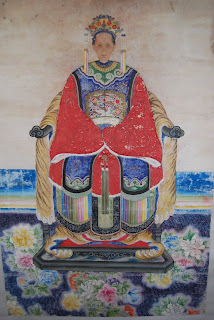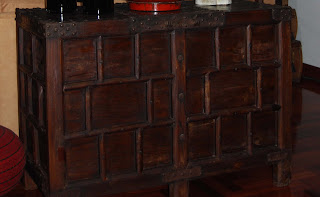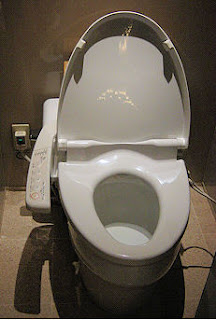[Images of a local temple in Taipei, Taiwan. Typical Asian colors, typical design,
an abundance of red and gold and lots of icons and symbols]
As I now prepare to leave Taiwan I begin to reflect upon my experiences and personal growth in a foreign land and foreign culture. When I first arrived, my point of view on the Taiwanese design style was, well….lets say ‘conservative.’ I found myself completely overwhelmed by the over use of vibrant color and opulent detail and the peculiar mix of old and new, it was a far cry from the cultural design imprint stamped into my brain. I think it just put my design sensibility on over load and eventually forced me to open myself up to true Asian design and the realization that this was not Asian infused design as I had more often seen in the western hemisphere.
In time, I began to appreciate the cultural significance of the ornate details and liberal use of red and gold. In context it began to make sense and allowed for acceptance and ultimately, appreciation of this new world of design I was exposed to. Without going into great detail about the popular elements of Asian design, red and gold are auspicious colors in Asia; being a very superstitious culture, this explains quite a lot about what you see and what people are doing.
So I set out to broaden my horizons and to learn and grow from this opportunity, luckily I’ve had the pleasure of meeting several interior designers, some local and some from other countries practicing here in Taiwan. We’ve had some interesting discussions about Feng Shui and it always boils down to what I call ‘common sense design’ combined with a strong dose of superstition….but that’s a whole other conversation!
In two short years of hunting for interesting objects, I have come to the conclusion that one great find always leads to an educational experience which always leads to another. This in itself has made the hunt more interesting because my curiosity always gets the best of me and I end up researching for all the details I can uncover.
At first I began searching for traditional Taiwanese furniture, they say that it has some very distinct characteristics, some not seen anywhere else in Asia. I quickly learned that finding anything old from Taiwan is literally impossible, so my energy was quickly diverted to objects from other parts of Asia.
My disappointment was short lived as I scoured antique shops, warehouses and back alley stores I found a variety of things, the most exciting being a set of commemorative ancestral portrait paintings from China. I was quickly told that these have become quite rare in China; apparently families have been selling them off because they needed money. Additionally, the art itself has completely died out because of the camera and painted portraits are no longer being commissioned; a real shame if you ask me.
By now you are probably asking, “What are commemorative ancestral paintings?” I’m happy to tell you because I find them absolutely fascinating; they are commissioned portraits by family members, sometimes while the person was still living, but often after the person had died. It is believed that one could communicate with the ancestral spirit by hanging his/her portrait and praying, burning incenses, placing food, wine, flowers etc. on an altar in front of the portrait. Many of these paintings are quite damaged since they were exposed to the elements for decades, so restorations are to be expected.
Paintings done during various periods contain certain elements, those of the Qing dynasty always have the person faced forward with a solemn expression on his/her face, they were usually seated in a chair with a rounded back, which indicated status or honor, and was always draped with patterned silk or tiger skin. The sitter wore a robe that identified his/her rank, a hat and sometimes there was a rug or carpet on the floor. There are significant differences in finished portraits if the person was of civil rank, military or from the Imperial family.


[Pair of ancestral paintings-partially restored, husband and wife. Wife's painting appears much older, indicating an earlier death than her husband. Wife's headdress has scripting which translate to "Heaven gives this order" a term which adds power to words and often came before a message from the Chinese Emperor, giving a title to someone. Painted on rice paper and mounted on silk; legitimate portraits are typically 180x115cm, forgeries are often smaller]
During this same period, robes indicated rank and had a rank badge/patch with details which identified his/her status. Symbols for civil ranks included the crane, pheasant, peacock, goose etc. in level of importance and military ranks with the lion, leopard, tiger, bear, panther etc. Experts can authenticate portraits by clues in each painting which include the above badges but also include details in rug patterns and rug designs.


[Both square badges indicate civil ranking of the imperial court, the female appears to be of a higher rank in society because of the crane, the male of a lower status but both in court robes. Wide borders and intricate detail around the badges indicate this is late 18th- early19th century of the Ch'ing Dynasty]
Only the better quality portraits included rugs because of the time and expense in painting them. Rugs were considered a luxury and their presence enhanced the status of the subject. Rugs were usually painted using the pointillism technique to represent the knots of the rug.
A final important detail about ancestral portraits is that the face was painstaking painted in great detail to ensure that it reflected their ancestor’s image and not someone else. There was tremendous fear that if the painting did not resemble their ancestor, their prayers and offerings might go to the wrong person.


[Both individuals have somber facial expressions, the male appears to be wearing a court hat with gold finial and no jeweled knob at the top, this verifies his ranking at the 7th level of civil rank (there are 9 levels, 9th is the lowest) The female has a very ornate headdress and I am still researching the significance this carries]
Intriguing isn’t it?
A second interesting discovery was a wooden coin chest found in a dank and dirty store with furniture and things piled in front and on top, making it virtually unnoticeable. Once we cleared the way, I found a sturdy wood chest with decorative elements-iron plates and studs; the best part was it was completely finished on all four sides, quite unusual I was told. The construction is easy to identify, with mortise and tenon joints, it appears to be elm and the wood is rock like, confirming age. There is a small door in the top which allows for access to the inside which was apparently used to store coins and other important items of small size. There seem to be conflicting reports of its origin, either from China or Burma, but it is said to date to the early to mid 1800's.


[Large rectangular coin chest with iron fittings of bolts and studs, detail is
complete on all four sides, considered rare]
These last photos are just fun finds I thought I’d share. Below are some really cool, round red cloth lanterns with iron fretting, a reproduction Qing Dynasty horse, an old bronze statute, terracotta warrior statues, some quirky chairs and life sized Thai statues and of course the typical mounted ‘wheel’ and offering urn.
I'm certain to have fun mixing these with all my other treasures; it’s a good thing I love eclectic design as you can imagine that nothing I own matches!!
All in all, living in Taiwan has been an eye opening experience and it reaffirms my thoughts that we are all students in life and our life experiences just scratch the surface of the world of design we are yet to discover.
 A palette of wine country colors with a natural earthy, rustic feel consisting of taupe, olive, grape vine greens, lavender grays and sky blue hues combined with lusty wine colors. This palette implies comfort, informal, hospitable, nonchalant settings.
A palette of wine country colors with a natural earthy, rustic feel consisting of taupe, olive, grape vine greens, lavender grays and sky blue hues combined with lusty wine colors. This palette implies comfort, informal, hospitable, nonchalant settings. A palette which mixes designer boutique with shabby chic colors using reused or natural fibers with plant dyes. This palette consists of unbleached white, tender greens, clouded coral, toasty warm tans and cool grays punctuated by velvety red rose tones. This color palette implies non contrived, effectual, a lack of excess and natural fibers.
A palette which mixes designer boutique with shabby chic colors using reused or natural fibers with plant dyes. This palette consists of unbleached white, tender greens, clouded coral, toasty warm tans and cool grays punctuated by velvety red rose tones. This color palette implies non contrived, effectual, a lack of excess and natural fibers.  A palette of colors which marries disconcerting taste with tradition equals an eclectic style mixed with tradition to which new finishes and textures emerge. This palette consists of classic crystal, antique white, caviar black, red mahogany, champagne beige, metallic silver and gold with warm purple orchid colors which add an exotic effect. The effect of this color palette is time honored, tasteful mixes, quality, prestige and historically significant.
A palette of colors which marries disconcerting taste with tradition equals an eclectic style mixed with tradition to which new finishes and textures emerge. This palette consists of classic crystal, antique white, caviar black, red mahogany, champagne beige, metallic silver and gold with warm purple orchid colors which add an exotic effect. The effect of this color palette is time honored, tasteful mixes, quality, prestige and historically significant. 

 A palette that captures the dynamic power of the sun yet also depicts rays of color that symbolizes fossil fuels includes a variation of mandarin and flame orange with radiating gold’s and green based yellows which reinforce vitality. Mauled purplish red, fuchsia red and electric blue add dimension, while ashy gray adds a calming neutral influence. This effect of this palette is resounding, vigorous and full of life, heat waves, produces power and heated surfaces.
A palette that captures the dynamic power of the sun yet also depicts rays of color that symbolizes fossil fuels includes a variation of mandarin and flame orange with radiating gold’s and green based yellows which reinforce vitality. Mauled purplish red, fuchsia red and electric blue add dimension, while ashy gray adds a calming neutral influence. This effect of this palette is resounding, vigorous and full of life, heat waves, produces power and heated surfaces.  A palette that is inspired by Japanese animee and brings life and activity. This palette of colors consists of clashing colors and brings new appreciation to vitality and creativity of unique color combinations. There are numerous possibilities for unlikely mixes which include opulent reds, vibrant blues, mint; positioned net to light apricot and quite green and deepened berry. The feeling this palette provokes is of diverse sensibilities, vital, enthusiastic, comedic, cunning, one of a kind.
A palette that is inspired by Japanese animee and brings life and activity. This palette of colors consists of clashing colors and brings new appreciation to vitality and creativity of unique color combinations. There are numerous possibilities for unlikely mixes which include opulent reds, vibrant blues, mint; positioned net to light apricot and quite green and deepened berry. The feeling this palette provokes is of diverse sensibilities, vital, enthusiastic, comedic, cunning, one of a kind. 





















